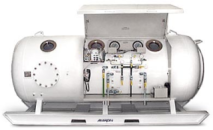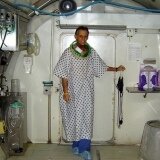Subdural Empyema, Other Intracranial Abscesses and HBOT

Subdural empyema and other intracranial or cerebral abscesses are usually caused by anaerobic bacteria (bacteria that function optimally in low oxygen concentrations). Surgical treatment options include aspiration, craniotomy and complete excision or craniotomy and marsupialisation. Unfortunately, normal brain tissue surrounding the abscess may be unavoidably damaged by such surgery. Fine needle aspiration of the abscesses is being performed with greater frequency to avoid this problem.
The majority of intracranial abscesses contain several mixed pathogens. In many patients, particularly those with sinus or ear infections a variety of aerobic and microaerophilic Streptococcal species are found (e.g. Strep millari; Strep pneumoniae, Strep pyogenes), often in combination with Haemophilus influenzae and Pseudomonas aeriginosa and anaerobes such as Bacteroides. In patients with a primary skin infection or an abscess complicating recent neurosurgery, Staphylococcus aureus is prevalent.
Hyperbaric oxygen raises the environmental oxygen level in the region of the abscess, exposing the bacteria to levels which may inhibit or kill them, as well as providing sufficient oxygen for white blood cells to exercise their killing power.
©2008 Undersea and Hyperbaric Medical Society, Inc. The book can be purchased at UHMS web site.
Intracranial Abscess
Reviewed by Irving Jacoby, M.D., FACEP
The term intracranial abscess (ICA) includes the following disorders: cerebral abscess, subdural empyema and epidural empyema. These disorders share many diagnostic as well as therapeutic similarities, and frequently, very similar pathophysiologic origins.
The overall mortality described in six case series of ICA from different countries during the years 1981-1986 ranged from 10 to 36%, with a summed death rate of 22%. During the years 1987-1993, the mortality may have decreased slightly, with a summed death of 18%. From the total of these 21 studies, the average mortality still remains at 20%. This is confirmed in the recent literature.
Because of improving mortality, there is a general trend toward a more conservative therapeutic approach in the management of ICA patients. This is reflected in the current international literature. However, patients with certain conditions and complications still pose major therapeutic problems. These include patients with: (1) multiple abscesses, (b) abscess in a deep or dominant location, (c) immune compromise, and (d) no response or further deterioration in spite of standard surgical and antibiotic treatment.
Preliminary experience using adjunctive HBO2 to treat patients with ICA has been favorable. To date, 48 such patients have been treated with 2% mortality. These include 16 consecutive patients reported in a series from Germany, 18 patients treated in Austria, 8 patients treated in France (4 with brain abscess; 4 with subdural and epidural empyema), and an additional 6 patients treated under the same conditions in several centers in the United States. The single death to date occurred in a patient with epidural empyema who had suffered hemispheric venous infarction from superior longitudinal sinus thrombosis prior to referral for Hyperbaric Oxygen Therapy.
Adjunct HBO2 should be considered under the following conditions:
- Multiple abscesses
- Abscesses in a deep or dominant location
- Compromised host
- In situations where surgery is contraindicated or where the patient is a poor surgical risk
- No response or further deterioration in spite of standard surgical (e.g. 1-2 needle aspirates) and antibiotic treatment.
The low mortality of ICA patients treated with HBO2 as adjunct therapy is very encouraging. However, only a limited number of cases have been reported to date. In an attempt to collect information on a larger population of treated patients such that valid statistical comparisons can be made, the UHMS Therapy HBO2 Committee is collecting case reports on additional such patients. It is requested that the critical parameters of the case and the results of treatment should be forwarded to the Chairman of the Committee at the address listed in the front of this Report. A specific questionnaire will then be forwarded to the treating physician to ensure that the necessary information regarding the case will be recorded.121
The average mortality from Subdural Empyema and other intractanial brain abscesses reported in six large series was 20% when hyperbaric oxygen (HBO2) was not used. Among the known cases treated with HBO2 to date, the mortality has been about 2%. Additionally, most of the patients treated with hyperbaric oxygen have returned to their regular daily activity after recovery, with less apparent brain damage. Therapy with HBO2 carries minimal risk, so the risk-benefit ratio is not arguable.












